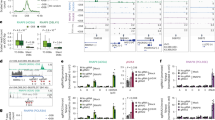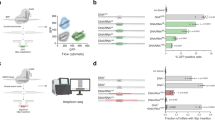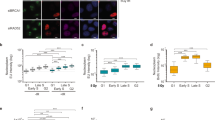Abstract
Repair of double strand breaks (DSBs) by RNA-binding proteins (RBPs) is vital for ensuring genome integrity. DSB repair is accompanied by local transcriptional repression in the vicinity of transcriptionally active genes, but the mechanism by which RBPs regulate transcriptional regulation is unclear. Here, we demonstrated that RBP hnRNPA2B1 functions as a RNA polymerase-associated factor that stabilizes the transcription complex under physiological conditions. Following a DSB, hnRNPA2B1 is released from damaged chromatin, reducing the efficiency of RNAPII complex assembly, leading to local transcriptional repression. Mechanistically, SIRT6 deacetylates hnRNPA2B1 at K113/173 residues, enforcing its rapid detachment from DSBs. This process disrupts the integrity of the RNAPII complex on active chromatin, which is a pre-requisite for transient but complete repression of local transcription. Functionally, the overexpression of an acetylation mimic stabilizes the transcription complex and facilitates the functioning of the transcription machinery. hnRNPA2B1 acetylation status was negatively correlated with SIRT6 expression, and acetylation mimic enhanced radio-sensitivity in vivo. Our findings demonstrate that hnRNPA2B1 is crucial for transcriptional repression. We have uncovered the missing link between DSB repair and transcriptional regulation in genome stability maintenance, highlighting the potential of hnRNPA2B1 as a therapeutic target.
This is a preview of subscription content, access via your institution
Access options
Subscribe to this journal
Receive 12 print issues and online access
$259.00 per year
only $21.58 per issue
Buy this article
- Purchase on SpringerLink
- Instant access to full article PDF
Prices may be subject to local taxes which are calculated during checkout







Similar content being viewed by others
Data availability
Any additional information and materials in this paper are available from the corresponding author upon reasonable request.
References
Jackson SP, Bartek J. The DNA-damage response in human biology and disease. Nature. 2009;461:1071–8.
Murray JM, Carr AM. Integrating DNA damage repair with the cell cycle. Curr Opin Cell Biol. 2018;52:120–5.
Aguilera A, García-Muse T. Causes of genome instability. Ann Rev Genet. 2013;47:1–32.
Tubbs A, Nussenzweig A. Endogenous DNA damage as a source of genomic instability in cancer. Cell. 2017;168:644–56.
Zhang H, Lu W, Zhou Y, Jiang Y. Advances in DNA damage induced by environmental chemical carcinogens. Genome Instab Dis. 2022;3:317–30.
Zhang J, Chen F, Tang M, Xu W, Tian Y, Liu Z, et al. The ARID1A-METTL3-m6A axis ensures effective RNase H1-mediated resolution of R-loops and genome stability. Cell Rep. 2024;43:113779.
Tiwari V, Wilson DM. 3rd. DNA damage and associated DNA repair defects in disease and premature aging. Am J Hum Genet. 2019;105:237–57.
Vázquez-García I, Uhlitz F, Ceglia N, Lim JLP, Wu M, Mohibullah N, et al. Ovarian cancer mutational processes drive site-specific immune evasion. Nature. 2022;612:778–86.
Jeggo PA, Pearl LH, Carr AM. DNA repair, genome stability and cancer: a historical perspective. Nat Rev Cancer. 2016;16:35–42.
Maynard S, Fang EF, Scheibye-Knudsen M, Croteau DL, Bohr VA. DNA damage, DNA repair, aging, and neurodegeneration. Cold Spring Harbor Perspect Med. 2015;5:a025130.
Zhang J, Chen F, Tian Y, Xu W, Zhu Q, Li Z, et al. PARylated PDHE1α generates acetyl-CoA for local chromatin acetylation and DNA damage repair. Nat Struct Mol Biol. 2023;30:1719–34.
Sancar A, Lindsey-Boltz LA, Unsal-Kaçmaz K, Linn S. Molecular mechanisms of mammalian DNA repair and the DNA damage checkpoints. Ann Rev Biochem. 2004;73:39–85.
Lans H, Hoeijmakers JHJ, Vermeulen W, Marteijn JA. The DNA damage response to transcription stress. Nat Rev Mol Cell Biol. 2019;20:766–84.
Jia N, Guo C, Nakazawa Y, van den Heuvel D, Luijsterburg MS, Ogi T. Dealing with transcription-blocking DNA damage: repair mechanisms, RNA polymerase II processing and human disorders. DNA Repair. 2021;106:103192.
Meisenberg C, Pinder SI, Hopkins SR, Wooller SK, Benstead-Hume G, Pearl FMG, et al. Repression of transcription at DNA breaks requires cohesin throughout interphase and prevents genome instability. Mol Cell. 2019;73:212–23.e217.
Awwad SW, Abu-Zhayia ER, Guttmann-Raviv N, Ayoub NNELF-. E is recruited to DNA double-strand break sites to promote transcriptional repression and repair. EMBO Rep. 2017;18:745–64.
Dreyfuss G, Kim VN, Kataoka N. Messenger-RNA-binding proteins and the messages they carry. Nat Rev Mol Cell Biol. 2002;3:195–205.
Liu Y, Shi SL. The roles of hnRNP A2/B1 in RNA biology and disease. Wiley Interdiscip Rev RNA. 2021;12:e1612.
Klaric JA, Wüst S, Panier S. New faces of old friends: emerging new roles of RNA-binding proteins in the DNA double-strand break response. Front Mol Biosci. 2021;8:668821.
Polo SE, Blackford AN, Chapman JR, Baskcomb L, Gravel S, Rusch A, et al. Regulation of DNA-end resection by hnRNPU-like proteins promotes DNA double-strand break signaling and repair. Mol Cell. 2012;45:505–16.
Yang YG, Qi Y. RNA-directed repair of DNA double-strand breaks. DNA Repair. 2015;32:82–85.
Xu H, Li P, Wang X, Zhuang H, Hua ZC. Emerging roles of hnRNP A2B1 in cancer and inflammation. Int J Biol Macromol. 2022;221:1077–92.
Chu M, Wan H, Zhang X. Requirement of splicing factor hnRNP A2B1 for tumorigenesis of melanoma stem cells. Stem Cell Res Therapy. 2021;12:90.
Meyer KD, Jaffrey SR. The dynamic epitranscriptome: N6-methyladenosine and gene expression control. Nat Rev Mol Cell Biol. 2014;15:313–26.
Villarroya-Beltri C, Gutiérrez-Vázquez C, Sánchez-Cabo F, Pérez-Hernández D, Vázquez J, Martin-Cofreces N, et al. Sumoylated hnRNPA2B1 controls the sorting of miRNAs into exosomes through binding to specific motifs. Nat Commun. 2013;4:2980.
Wang L, Wen M, Cao X. Nuclear hnRNPA2B1 initiates and amplifies the innate immune response to DNA viruses. Science. 2019;365:eaav0758.
Zhu S, Hou J, Gao H, Hu Q, Kloeber JA, Huang J, et al. SUMOylation of HNRNPA2B1 modulates RPA dynamics during unperturbed replication and genotoxic stress responses. Mol Cell. 2023;83:539–55.
Amaya J, Ryan VH, Fawzi NL. The SH3 domain of Fyn kinase interacts with and induces liquid-liquid phase separation of the low-complexity domain of hnRNPA2. J Biol Chem. 2018;293:19522–31.
Guha M, Fang JK, Monks R, Birnbaum MJ, Avadhani NG. Activation of Akt is essential for the propagation of mitochondrial respiratory stress signaling and activation of the transcriptional coactivator heterogeneous ribonucleoprotein A2. Mol Biol Cell. 2010;21:3578–89.
Guha M, Pan H, Fang JK, Avadhani NG. Heterogeneous nuclear ribonucleoprotein A2 is a common transcriptional coactivator in the nuclear transcription response to mitochondrial respiratory stress. Mol Biol Cell. 2009;20:4107–19.
Ma KW, Au SW, Waye MM. Over-expression of SUMO-1 induces the up-regulation of heterogeneous nuclear ribonucleoprotein A2/B1 isoform B1 (hnRNP A2/B1 isoform B1) and uracil DNA glycosylase (UDG) in hepG2 cells. Cell Biochem Funct. 2009;27:228–37.
Wang H, Liang L, Dong Q, Huan L, He J, Li B, et al. Long noncoding RNA miR503HG, a prognostic indicator, inhibits tumor metastasis by regulating the HNRNPA2B1/NF-κB pathway in hepatocellular carcinoma. Theranostics. 2018;8:2814–29.
Xuan Y, Wang J, Ban L, Lu JJ, Yi C, Li Z, et al. hnRNPA2/B1 activates cyclooxygenase-2 and promotes tumor growth in human lung cancers. Mol Oncol. 2016;10:610–24.
Zhao K, Zhou Z. Post-translational modifications of nuclear sirtuins. Genome Instab Dis. 2020;1:34–45.
North BJ, Verdin E. Sirtuins: Sir2-related NAD-dependent protein deacetylases. Genome Biol. 2004;5:224.
Chen F, He X, Xu W, Zhou L, Liu Q, Chen W, et al. Chromatin lysine acylation: on the path to chromatin homeostasis and genome integrity. Cancer Sci. 2024;2024. https://doi.org/10.1111/cas.16321.
Zhang J, Lu X, MoghaddamKohi S, Shi L, Xu X, Zhu W-G. Histone lysine modifying enzymes and their critical roles in DNA double-strand break repair. DNA Repair. 2021;107:103206.
Chen B, Zang W, Wang J, Huang Y, He Y, Yan L, et al. The chemical biology of sirtuins. Chem Soc Rev. 2015;44:5246–64.
Mao Z, Hine C, Tian X, Van Meter M, Au M, Vaidya A, et al. SIRT6 promotes DNA repair under stress by activating PARP1. Science. 2011;332:1443–6.
Geng A, Tang H, Huang J, Qian Z, Qin N, Yao Y, et al. The deacetylase SIRT6 promotes the repair of UV-induced DNA damage by targeting DDB2. Nucleic Acids Res. 2020;48:9181–94.
Mostoslavsky R, Chua KF, Lombard DB, Pang WW, Fischer MR, Gellon L, et al. Genomic instability and aging-like phenotype in the absence of mammalian SIRT6. Cell. 2006;124:315–29.
Toiber D, Erdel F, Bouazoune K, Silberman DM, Zhong L, Mulligan P, et al. SIRT6 recruits SNF2H to DNA break sites, preventing genomic instability through chromatin remodeling. Mol Cell. 2013;51:454–68.
Hou T, Cao Z, Zhang J, Tang M, Tian Y, Li Y, et al. SIRT6 coordinates with CHD4 to promote chromatin relaxation and DNA repair. Nucleic Acids Res. 2020;48:2982–3000.
Dong C, West KL, Tan XY, Li J, Ishibashi T, Yu CH, et al. Screen identifies DYRK1B network as mediator of transcription repression on damaged chromatin. Proc Natl Acad Sci USA. 2020;117:17019–30.
Shanbhag NM, Rafalska-Metcalf IU, Balane-Bolivar C, Janicki SM, Greenberg RA. ATM-dependent chromatin changes silence transcription in cis to DNA double-strand breaks. Cell. 2010;141:970–81.
Jao CY, Salic A. Exploring RNA transcription and turnover in vivo by using click chemistry. Proc Natl Acad Sci USA. 2008;105:15779–84.
Moquin DM, Genois MM, Zhang JM, Ouyang J, Yadav T, Buisson R, et al. Localized protein biotinylation at DNA damage sites identifies ZPET, a repressor of homologous recombination. Genes Dev. 2019;33:75–89.
Huang T, Zhu G, Chen F. The potential impact of HNRNPA2B1 on human cancers prognosis and immune microenvironment. J Immunol Res. 2024;2024:5515307.
Mikolaskova B, Jurcik M, Cipakova I, Kretova M, Chovanec M, Cipak L. Maintenance of genome stability: the unifying role of interconnections between the DNA damage response and RNA-processing pathways. Curr Genet. 2018;64:971–83.
Wickramasinghe VO, Venkitaraman AR. RNA processing and genome stability: cause and consequence. Mol Cell. 2016;61:496–505.
Gnan S, Liu Y, Spagnuolo M, Chen C-L. The impact of transcription-mediated replication stress on genome instability and human disease. Genome Instab Dis. 2020;1:207–34.
Calderwood SK. A critical role for topoisomerase IIb and DNA double strand breaks in transcription. Transcription. 2016;7:75–83.
Plosky BS. Regulating transcription traffic around DSBs. Mol Cell. 2015;58:391–2.
Shao W, Bi X, Pan Y, Gao B, Wu J, Yin Y, et al. Phase separation of RNA-binding protein promotes polymerase binding and transcription. Nat Chem Biol. 2022;18:70–80.
Bhowmick R, Mehta KPM, Lerdrup M, Cortez D. Integrator facilitates RNAPII removal to prevent transcription-replication collisions and genome instability. Mol Cell. 2023;83:2357–66.
Caron P, van der Linden J, van Attikum H. Bon voyage: a transcriptional journey around DNA breaks. DNA Repair. 2019;82:102686.
Nakazawa Y, Hara Y, Oka Y, Komine O, van den Heuvel D, Guo C, et al. Ubiquitination of DNA damage-stalled RNAPII promotes transcription-coupled repair. Cell. 2020;180:1228–44.e1224.
Tufegdžić Vidaković A, Mitter R, Kelly GP, Neumann M, Harreman M, Rodríguez-Martínez M, et al. Regulation of the RNAPII pool is integral to the DNA damage response. Cell. 2020;180:1245–61.e1221.
Lu Y, Wang X, Gu Q, Wang J, Sui Y, Wu J, et al. Heterogeneous nuclear ribonucleoprotein A/B: an emerging group of cancer biomarkers and therapeutic targets. Cell Death Discov. 2022;8:337.
Chen Z, Chen X, Lei T, Gu Y, Gu J, Huang J, et al. Integrative analysis of NSCLC identifies LINC01234 as an oncogenic lncRNA that interacts with HNRNPA2B1 and regulates miR-106b biogenesis. Mol Ther J Am Soc Gene Ther. 2020;28:1479–93.
Zhou B, Lu D, Wang A, Cui J, Zhang L, Li J, et al. Endoplasmic reticulum stress promotes sorafenib resistance via miR-188-5p/hnRNPA2B1-mediated upregulation of PKM2 in hepatocellular carcinoma. Mol Ther Nucleic Acids. 2021;26:1051–65.
Meng LD, Shi GD, Ge WL, Huang XM, Chen Q, Yuan H, et al. Linc01232 promotes the metastasis of pancreatic cancer by suppressing the ubiquitin-mediated degradation of HNRNPA2B1 and activating the A-Raf-induced MAPK/ERK signaling pathway. Cancer Lett. 2020;494:107–20.
Dai S, Zhang J, Huang S, Lou B, Fang B, Ye T, et al. HNRNPA2B1 regulates the epithelial-mesenchymal transition in pancreatic cancer cells through the ERK/snail signalling pathway. Cancer Cell Int. 2017;17:12.
Lang F, Liu Y, Chou FJ, Yang C. Genotoxic therapy and resistance mechanism in gliomas. Pharmacol Ther. 2021;228:107922.
Steinbichler TB, Dudás J, Skvortsov S, Ganswindt U, Riechelmann H, Skvortsova II. Therapy resistance mediated by cancer stem cells. Semin Cancer Biol. 2018;53:156–67.
Patterson-Fortin J, Bose A, Tsai WC, Grochala C, Nguyen H, Zhou J, et al. Targeting DNA repair with combined inhibition of NHEJ and MMEJ induces synthetic lethality in TP53-mutant cancers. Cancer Res. 2022;82:3815–29.
Qiu L, Xu W, Lu X, Chen F, Chen Y, Tian Y, et al. The HDAC6-RNF168 axis regulates H2A/H2A.X ubiquitination to enable double-strand break repair. Nucleic Acids Res. 2023;51:9166–82.
Li Z, Xu W, Chen F, Zhang J, Zhu W-G. BET inhibitors enhance the anti-cancer effect of etoposide by suppressing the MRN-ATM axis in the DNA damage response. Genes Dis. 2022;11:19–22.
Hou T, Tian Y, Cao Z, Zhang J, Feng T, Tao W, et al. Cytoplasmic SIRT6-mediated ACSL5 deacetylation impedes nonalcoholic fatty liver disease by facilitating hepatic fatty acid oxidation. Mol Cell. 2022;82:4099–115.e4099.
Tian Y, Feng T, Hou T, Zhu W-G. Protocol to purify the histone deacetylase SIRT6 and assess its activity in vitro. STAR Protoc. 2023;4:102206.
Acknowledgements
This work was supported by the National Natural Science Foundation of China [32090030, 32090033, 82430096, 82472781 and 82002986]; the Guangdong Basic and Applied Basic Research Foundation (2021A1515011126); the Shenzhen Municipal Commission of Science and Technology Innovation [JCYJ20220818100015032, JCYJ20220818100016034, RCYX20210706092040047]; the Shenzhen Medical Research Fund [A2303025 and B2302010]; the Shenzhen University 2035 Program for Excellent Research and Shenzhen University Startup Grant for Youth, and the Program for Youzuzhikeyan of Shenzhen University. The authors would like to thank Dr Roger Greenberg (University of Pennsylvania, USA) for providing the U2OS-DSB reporter cells, and Dr Jessica Tamanini of ETediting, UK for English language editing prior to submission.
Author information
Authors and Affiliations
Contributions
JZ and WGZ contributed to the design of the research, conceived the study, guided the research and revised the manuscript; FC, WCX, and JZ wrote the manuscript; FC, WCX, MT, YXS, and JZ performed the experimental study and analyzed data; XKH and QL helped the mice maintenance; MT provided the clinical tissue samples; LMZ analyzed the clinical samples; YT, QZ, and XPL discussed the study and provided suggestions.
Corresponding authors
Ethics declarations
Competing interests
The authors declare no competing interests.
Ethical approval and consent to participate
All methods were performed in accordance with the relevant guidelines and regulations. Studies using human specimens were approved by the Clinical Research Ethics Committee of Shenzhen University. The patients provided written informed consent to the use of their resected tissues for research purposes. All mouse experiments were approved by Shenzhen University Animal Care and Use Committee and were conducted in accordance with the National Institutes of Health Guidelines for the Care and Use of Laboratory Animals.
Additional information
Publisher’s note Springer Nature remains neutral with regard to jurisdictional claims in published maps and institutional affiliations.
Supplementary information
Rights and permissions
Springer Nature or its licensor (e.g. a society or other partner) holds exclusive rights to this article under a publishing agreement with the author(s) or other rightsholder(s); author self-archiving of the accepted manuscript version of this article is solely governed by the terms of such publishing agreement and applicable law.
About this article
Cite this article
Chen, F., Xu, W., Tang, M. et al. hnRNPA2B1 deacetylation by SIRT6 restrains local transcription and safeguards genome stability. Cell Death Differ 32, 382–396 (2025). https://doi.org/10.1038/s41418-024-01412-4
Received:
Revised:
Accepted:
Published:
Issue date:
DOI: https://doi.org/10.1038/s41418-024-01412-4
This article is cited by
-
hnRNPA2B1 restrains granulosa cell ferroptosis by m6A/SLC7A11 in premature ovarian failure
Journal of Ovarian Research (2025)
-
Fetuin-A: A novel protector of hematopoietic stem cell genomic stability
Genome Instability & Disease (2025)



